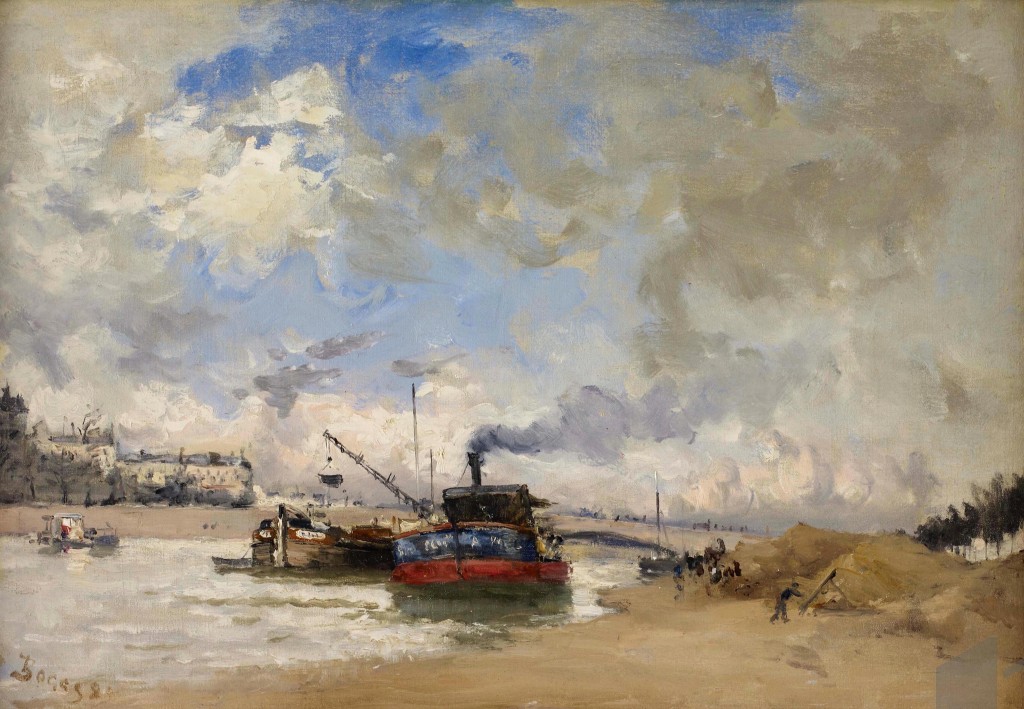The Seine, Outside Paris by Frank Boggs caught my eye on my first visit to the Hunter Museum about fifteen years ago. Since then, I go see it on most of my visits, and, like an old friend who never fails to charm, I always come away thrilled at its mastery of means and usually vow, with varying degrees of success, to emulate its immediacy in my own artwork.

Frank Boggs–“The Seine, Outside Paris”, 15 x 22, Oil on canvas, 1885– The Hunter Museum of American Art
When I first discovered this work I knew nothing about the artist but that mattered little. I avoid reading the information card next to a painting when viewing it for the first time, trying instead to let the artwork tell me all it can about itself, or at least as much as I can understand on a first viewing. So what can be deduced from this small canvas?
It was painted in the second half of the 19th century; the subject matter and the style make that clear enough. The relatively small size and the freedom of the brushwork suggests it was almost certainly done plein aire. Earlier in the century the development of paint packaged in tubes combined with the invention of the portable easel (still called a ‘French easel”) freed the artist from working exclusively in the studio. By the 1880’s it was a freedom that many younger artists increasingly relished and a common practice with painters such as Monet and Pissaro. Further suggesting its plein aire origins, this image has been painted on a tan colored ground, which can be seen in the foreground and behind the boats. Working directly on a toned ground, which is allowed to appear in the finished painting, both facilitates the visual cohesion of the image and speeds up the time necessary to capture the subject–not a small consideration when working outdoors with changing light conditions and environmental distractions. My guess is that this painting, almost an oil sketch, was 99% finished on the spot with very minor touches added in the studio. Great care has been taken by the artist to keep its spontaneity intact.
The economy of means and the freedom of technique are supported by a simple and effective composition. The darks are spotted judiciously, which, when combined with the swirl of the steam and clouds form lines, give the whole a vigorous rhythm and energy. Essentially, the darks along the horizon line are crossed by a second ‘line’ of visual energy that begins with the white of the river water on the lower left and moves into the picture plane to the lower clouds behind the boast. These compositional lines cross at the boats, and given the boat’s position in the painting and their dark tonality, make them the focus of the work. But Boggs goes further. By utilizing the swirl of steam and clouds above his primary subject, which he has placed on an unusually low horizon line, he gives the painting additional energy.
Of course I eventually read the information card and made the acquaintance of Frank Myers Boggs. I had not heard of him, but there are many fine artists who are not household names. When I got home an Internet search provided the following:
Frank Myers Boggs was born in Springfield, Ohio, but left Ohio in 1876 for study with Jean-Léon Gérôme at the École des Beaux Arts in Paris. He lived in Paris and New York, residing the last thirty years of his life in Paris. In Paris he won wide recognition for his atmospheric paintings of the ports of France and the quays along the Seine. His works were exhibited frequently in France. Between 1879 and 1916, his work was also shown in the United States, most often at the National Academy of Design, in New York, and at the Pennsylvania Academy of the Fine Arts, in Philadelphia.
Known as a master of plein-air painting, Boggs delighted in capturing the fleeting effects of the constantly changing skies of northern France and southern England. With lush and broad brush strokes, Boggs created rich and spacious paintings, orchestrating a subtle and restrained palette of grays, deep and dusty blues, and earthy tans. Although his palette is more subtle and tonal than that of the French Impressionist Claude Monet, Boggs’ paintings demonstrate clear affinities with the early French Impressionist school. Like his fellow Impressionists, it was the transitory aspects of nature, as well as the documentation of everyday reality, to which Boggs was keenly sensitive. –Keny Galleries- Columbus, OH)
So there you have it. The Seine Outside Paris is a small painting made by an American artist not much known today. Yet it contains much of value and, almost like a visual haiku, says much within the confines of its simplicity.